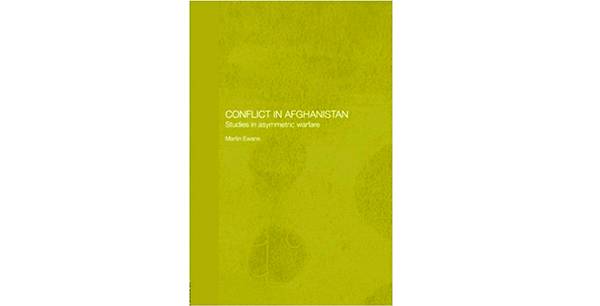
Conflict in Afghanistan: Studies in Asymmetric Warfare
Martin Ewans
Routledge (2014)
Rs9,680
Asymmetric warfare, involving conflicts where smaller powers apply their strengths against the weaknesses of a more powerful opponent, has become a key modern concern since the September 11th attacks. Conflict in Afghanistan tackles this issue by examining the five wars Afghanistan has waged against foreign powers over the past two centuries, all of which have involved forms of asymmetric warfare.
Incorporating contemporary documents and material from Soviet archives, the text analyzes each war’s antecedents, conduct, and consequences. Important questions are asked about the role of religious beliefs, fanaticism, diplomacy, governmental decision-making and military competence, issues that have great contemporary relevance. The book provides an illuminating commentary of Afghanistan’s wars and examines the relevance of these conflicts to the modern-day challenge of counter-insurgency and asymmetric warfare.
Sir Martin Ewans is a retired diplomat with considerable experience of South Asia, including three years as Head of Chancery in Kabul.
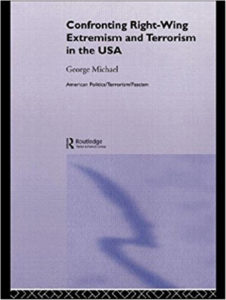
Confronting Right Wing Extremism and Terrorism in the USA
George Michael
Routledge (2003)
Rs8,451
Is there a right-wing extremist threat in America? Are domestic terrorists gaining strength? How does America respond to the extreme right challenge? Right wing extremism in the United States has received considerable attention in recent years, yet few studies have simultaneously examined the response of government and non-governmental organizations to the threat these groups embody. The unique constitutional tradition of civil liberties in America means that the government is unable to disband a group simply because they have unpopular ideas, as a result private non-governmental organizations (NGOs) have stepped in to heavily influence this area of US public policy. Confronting Right Wing Extremism and Terrorism in the USA provides a detailed portrait of the contemporary extreme right in the US and includes interviews with several of the movement’s leading figures from groups such as the Ku Klux Klan, Militias, American Renaissance and the White Aryan Resistance. The author persuasively explains how the activities of these racist groups have been curbed due to the campaigning efforts of anti-racist and anti-fascist watchdogs. This study draws upon declassified government documents, NGO reports and extremist literature to provide a thought provoking account of the extreme right challenge in America. It will provide an invaluable resource to students of terrorism, political violence and right wing extremism as well as appealing to the general reader with an interest in contemporary American politics.
George J. Michael (born January 30, 1961) is an American associate professor at the criminal justice faculty of Westfield State University in Massachusetts, and previously served as associate professor of nuclear counterproliferation and deterrence theory at the Air War College and as associate professor of political science and administration of justice at The University of Virginia’s College at Wise. He studies right-wing extremism, including the relationship between militant Islam and the far right, and is the author of The Enemy of My Enemy: The Alarming Convergence of Militant Islam and the Extreme Right (2006), Willis Carto and the American Far Right (2008), and Theology of Hate: A History of the World Church of the Creator (2009).
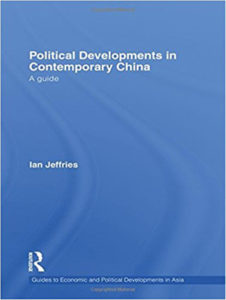
Political Developments in Contemporary China: A Guide
Ian Jeffries
Routledge (2010)
Rs19,207
China’s role in global events today cannot be overestimated. This book provides a comprehensive and detailed overview of contemporary political developments in China. Key topics covered include: China’s international relations with its neighbours and with the international community more widely; demographic developments; Taiwan; Macao and Hong Kong, Tibet, Uighurs; human rights, health issues (including bird flu); food contamination and defective goods; and a chronology of political developments, congresses and Central Committee sessions since May 2006; the earthquake of 12 May 2008 and the 2008 Olympic Games.
The book continues - and adds to – the overview of developments up to May 2006 which were covered in the author’s China: A Guide to Economic and Political Developments (2006), and is the companion volume to Economic Developments in Contemporary China: A Guide (2010) - both published by Routledge.
Ian Jeffries is Honorary Professor in the Department of Economics in the School of Business and Economics at Swansea University, UK. He is the author of numerous books in the series, Guides to Economic and Political Developments in Asia, including volumes on North Korea, Vietnam, China and Mongolia.
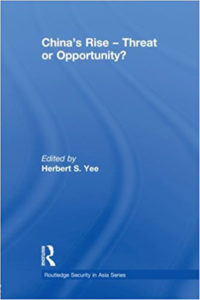
China’s Rise - Threat or Opportunity?
Herbert S. Yee
Routledge (2013)
Rs13,061
The phenomenal growth of Chinese economic and military power in the first decade of the 21st century has drawn world-wide attention. Perceptions of China’s rise have shifted from seeing China as a threat to a more mixed view, where China is seen as playing a key role in economic recovery, taking an increasingly responsible role in world affairs, and contributing significantly to scientific and technological advances.
This book argues that China will only become a truly global power when its rising power status is accepted, or at least tolerated, by other major powers and China’s neighbours. Filling a major gap in the existing literature, it presents a comprehensive overview of how China’s rise is perceived in a wide range of countries and regions – these include China’s neighbours, other world powers, the parts of China not part of mainland China - Taiwan, Hong Kong and Macau - and regions of the world where China is having an unexpected impact, such as the Middle East. It also examines changing perceptions of China in the western media. Overall, the book demonstrates that whilst many countries and regions are much more positive about China’s rise than they were before, considerable nervousness and concern persists.
Herbert S. Yee is currently Visiting Professor of Politics and International Relations at the Macau Polytechnic Institute, China, and former Professor in the Department of Government and International Studies at Hong Kong Baptist University. His recent publications include (as co-editor) The China Threat: Perceptions, Myths and Reality (also published by Routledge) and Return of the Dragon: US-China Relations in the 21st Century.
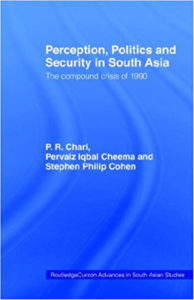
Perception, Politics and Security in South Asia: The Compound Crisis of 1990
PR Chari, Pervaiz Iqbal Cheema, Stephen P Cohen
Routledge (2003)
Rs15,366
This book provides a detailed examination of the compound crisis between India and Pakistan that brought the region to the brink of a nuclear war in 1990. Placing the crisis in the context of concurrent international events such as the fall of the Soviet Union, the authors draw out the lesson for present-day South Asian affairs. The book also makes a significant contribution to the debates on the role of nuclear weapons, confidence and security building strategies and the place of ethnicity in contemporary international relations.
In early 1990, a major crisis broke out in South Asia between India and Pakistan. This crisis has - with good reason - been much studied and discussed. However, it was not a single event but a confluence of actions, statements, and perceptions that interacted over the brief period of four months - it was thus shorter than other crises that have occurred in South Asia and elsewhere (such as the events that led to the war of 1971 between the two states, or the slow-mounting crisis that led to World War I), but it lasted considerably longer than the Cuban Missile Crisis of 1962. The crisis of early 1990 was preceded by the Brasstacks crisis of 1987, which lasted, in its critical phase, no more than a week or two. The 1990 crisis was followed in the next few years by several alarms, lasting two or three days at most, and then in 1999 by an even more serious confrontation between India and Pakistan in the Kargil region of Kashmir. In 2001-2 there was an extended crisis - some have called it brinkmanship, others have termed it “coercive diplomacy” - that brought the armed forces of India and Pakistan on a high state of alert for nearly six months.
In the minds of many outside observers, South Asia has become identified as a crisis-prone region, and since 1990 these crises have carried the threat of escalation from harsh diplomacy, to limited war, to a wider conventional war, to the possible use of nuclear weapons.
The crisis of 1990 was also significant in the sense that both participants and observers believed they were witnessing a progression of events that portended direct conflict. However, perspectives of the crisis differed significantly among observers and participants and have been judged differently with the benefit of hindsight.

